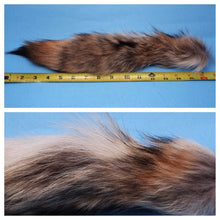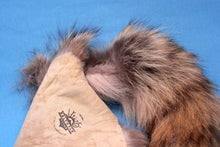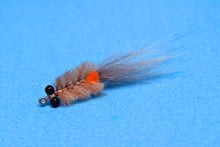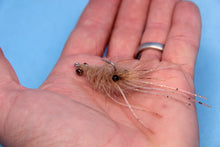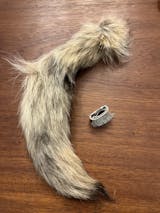
You want 'em, We got 'em … Coyote Tails For Fly Tying - The Perfect Material For Saltwater Flies!
These soft tanned select coyote tails avg. 16-18" in length and are quickly one of the most popular materials almost saltwater fly tyers. Fine underfur makes for fantastic dubbing, and the long stiff salt and pepper guard hairs are perfectly suited for bonefish tarpon and permit flies. The thick fur is a beautiful blend of cream, tan, gray, brown and black colors.
Coyote tail fur is quickly becoming one of my favorite materials for saltwater flies for several reasons… and the more I tie with coyote tail fur, the more I like it. A bushy coyote tail has a variety of hair lengths, and the natural tans, creams, grays, browns and blacks give it an extremely lifelike and natural against a sandy bottom. Perfect for larger flies like Clousers and Mantis shrimp patterns, flies tied with this multi colored fur will blend perfectly with with mottled bottoms … just like the creatures that live there.
Sold as 1 approximately 16-18" Soft Tanned Coyote Tail. Coloration varies with each coyote tail.
What make coyote tail fur so awesome?
I love coyote tail fur for its wide array of natural colors, and durability, but also because it’s thin stiff texture that allows you to create lifelike flies that don’t foul.
The vast majority of shrimp imitations utilize a synthetic wing material like craft fur, or polar fiber. Most of what you find today in your local fly shop is "extra select" Craft Fur, which has much longer fibers. Even if you pull out the longer fibers in an attempt to create a shorter tapered bundle to tie in for the tail, much of the material is waisted… and after you pick out the underfur from the butts of the material, there just isn’t much left to work with. This stuff is typically all one color (Cream, Tan, etc.) and nothing found in nature is all one color. In an effort to create better more realistic looking bonefish and permit flies, I started looking back in to natural materials.
At first I experimented with Arctic Fox and Finnish Raccoon, and their soft fibers really move wonderfully in the water. Unfortunately the same characteristics that give it a life like look, also causes it to foul constantly. Also, marabou and arctic fox tend to break and get bitten off by fish more easily than rabbit or coyote tail fur.
The answer to this conundrum… Coyote Tail Fur. This canine’s tail may be the perfect bonefish fly materials. Not only it slightly stiffer than the previously listed options so it doesn’t foul as easily, but it is also multi colored. The natural tans, creams, grays, browns and blacks give it an extremely natural look, that blend will with mottled bottoms … just like the creatures that live there. Coyote fur has long stiff guard hairs, that become supple when wet, and it’s soft under is perfect for dubbing. Long story short, I’m not certain there is any natural material finer than coyote fur for fly tying… It’s just about perfect for any bonefish tarpon or permit fly you want to tie.
What’s the difference between Coyote fur and Coyote Tail?
Difference Between Coyote Tail & Fur? Color, Length & Texture.
The thick and bushy coyote tail fur is a beautiful blend of cream’s, tan’s, gray’s, rush brown’s and black colors. The hairs are longer (4-5") and finer with a dense underfur.
Coyote Fur has shorter, stiffer guard hairs and a soft underfur. The color still varies, but the vast majority is more cream grays and blacks.
16-18" Soft Tanned Coyote Tail. Coloration varies with each coyote tail. Remember, this is a natural product so exact colors and dimensions may vary.
Pick Up Your Coyote Tail Today!




